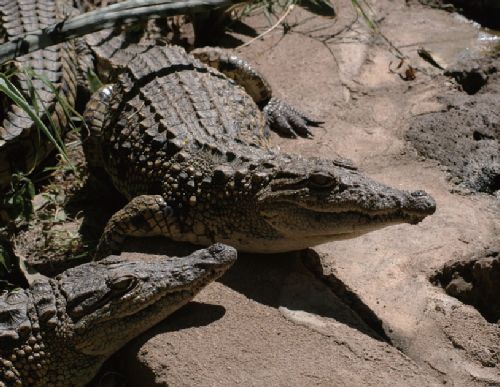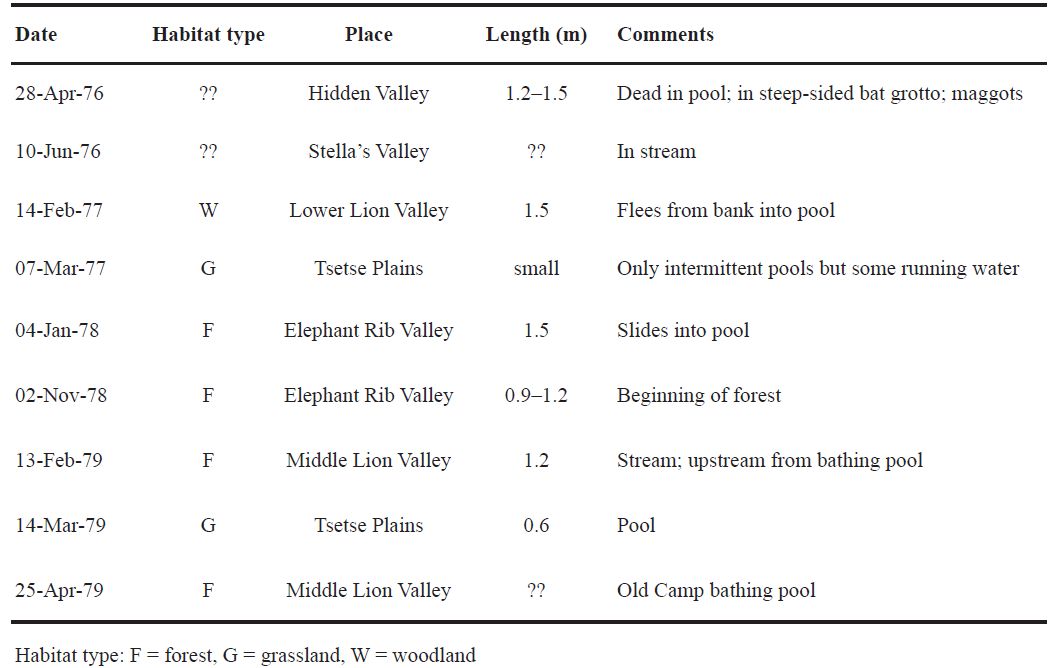|
<NOTE>
Encountering Crocodiles while Chasing Chimpanzees
William C. McGrew
Department of Archaeology & Anthropology, University of Cambridge, U.K. The Nile crocodile (Crocodylus niloticus) is sympatric with the chimpanzee (Pan troglodytes) across most or all of its range (IUCN 2013). The crocodile is a top predator and even when not fully grown is big enough to prey upon a chimpanzee. Crocodiles prey on smallerbodied monkeys (Galdikas & Yeager 1984; Galdikas 1985; Cheney & Seyfarth 2007). Njau and Blumenschine (2012) showed that crocodiles of only 1–2 m bodylength preyed on Homo habilis, whose body-size was chimpanzee-like. However, crocodiles are rarely listed as a potential predator in studies of wild chimpanzees. 
Nile crocodiles (Photo by M. Nakamura) In reports of the ethology and ecology of chimpanzees, crocodiles figure, if at all, only in passing comments (McGrew et al. 1996, p. 318). Risk of predation by aquatic predators, including crocodiles, is not mentioned in published accounts of chimpanzees’ avoidance of water (hydrophobia) (Angus 1971; McGrew 1977; Nishida 1980). There seem to be no detailed published data on interactions between the apes and these reptiles, nor any data on potential encounter rates between the two species. The aim of this short report is to present some data on chimpanzees and crocodiles in close sympatry, with the two species making use of the same watercourses at a single study site. If we have not yet seen crocodiles and chimpanzees encounter one another, then the next best source of data may be primatologists searching for or tracking unhabituated chimpanzees. Because such researchers seek to maximise the chances of contacting wild chimpanzees in their daily activities, the humans’ encounter rate may be a proxy for that of the apes. As Mt. Assirik, in the Parc National du Niokolo- Koba, Republic of Senegal, we studied chimpanzees (P. t. verus) over almost four years, from February 1976–December 1979. We spent each working day walking through various types of habitat, in search of chimpanzees. We focussed on gallery forest along seasonal watercourses, which, although comprising only 3% of the surface area of the 50 km², yielded most of the chimpanzee contacts. Assirik is a hot, dry, and open habitat dominated by grassland and open, deciduous woodland (McGrew et al. 1981). The dry season lasts for 7 months (November–May), during which time almost all watercourses either dry up or cease flowing. Assirik has no rivers but instead tributary streams of varying size, none more than 2 m in width. Chimpanzees drink daily and prefer running water; as the dry season progresses, they must make use of water in gallery forest strips. We encountered crocodiles nine times during the study (see Table 1). This equates to one encounter every 5.2 months (when the median number of days per spent in the field per month was 27). All but one of the encounters took place in the dry season, when the reptiles were confined to pools in watercourses. The exception (10 June 1976) was a dead individual in a shallow pool, ridden with maggots. Only half of the encounters were in closedcanopy gallery forest; the others were in more open habitat types. All crocodiles were immature, ranging from 1–1.5 m long. All retreated upon encountering us, into whatever water was available. Table 1. Details of encounters with crocodiles, Mt. Assirik, Senegal. Lacking permanent surface water, Assirik is probably too dry to maintain a population of crocodiles, but it seems likely that young crocodiles disperse in the rainy season up the rain-swollen tributaries of the Gambia River, bringing some of them into the main valleys of the study area. Those that did not retreat with the advancing dry season were probably trapped in diminishing pools, where they were temporarily more exposed and observable, but ultimately perished. Are crocodiles a predatory threat to the Assirik chimpanzees? Perhaps. ACKNOWLEDGEMENTS I thank the 15 other researchers who took data on animal encounters during the Assirik project, especially Caroline Tutin and the late Pamela Baldwin; Kazuhiko Hosaka and Michio Nakamura for helpful comments and suggestions on the manuscript. Writing of this report was supported by an Emeritus Fellowship from The Leverhulme Trust. REFERENCES Angus S 1971. Water-contact behavior of chimpanzees. Folia Primatol 14:51–58. Cheney DL, Seyfarth RM 2007. Baboon Metaphysics. University of Chicago Press, Chicago. Galdikas BMF, Yeager CP 1984. Crocodile predation on a crabeating macaque in Borneo. Am J Primatol 6:49–51. Galdikas BMF 1985. Crocodile predation on a proboscis monkey in Borneo. Primates 26:495–496. IUCN 2013. IUCN Red List of Threatened Species. http://www.iucnredlist.org/details/46590/0 McGrew WC 1977. Socialization and object manipulation of wild chimpanzees. In: Primate Bio-social Development. Chevalier-Skolnikoff S, Poirier FE (eds), Garland, New York, pp. 261–288. McGrew WC, Baldwin PJ, Tutin CEG 1981. Chimpanzees in a hot, dry and open habitat: Mt. Assirik, Senegal, West Africa. J Hum Evol 10:227–244. McGrew WC, Marchant LF, Nishida T (eds.) 1996. Great Ape Societies. Cambridge University Press, Cambridge. Nishida T 1980. Local differences in responses to water among wild chimpanzees. Folia Primatol 33:189–209. Njau JK, Blumenschine RJ 2012. Crocodylian and mammalian carnivore feeding traces on hominid fossils from FLK22 and FLK NN 3, Plio-Pleistocene, Olduvai Gorge, Tanzania. J Hum Evol 63:408–417. Back to Contents |
